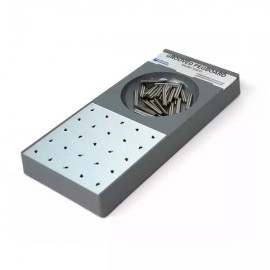Exploring the Grooved Pegboard Test 探索凹槽托板測試
Exploring the Grooved Pegboard Test: Assessing Fine Motor Skills and Coordination
探索凹槽托板測試:評估細微運動技巧和協調性
Introduction:
The Grooved Pegboard Test is a well-known assessment tool that evaluates an individual's fine motor skills, hand-eye coordination, and dexterity. It is widely used in various fields, including occupational therapy, neuropsychology, and research. In this article, we will delve into the purpose, administration, and significance of the Grooved Pegboard Test, shedding light on its role in assessing manual proficiency and its applications in different settings.
Purpose of the Grooved Pegboard Test:
The primary purpose of the Grooved Pegboard Test is to measure an individual's manual dexterity and coordination in performing precise hand movements. It assesses the ability to manipulate small pegs into corresponding grooved holes within a specified time frame. The test provides valuable insights into fine motor skills, hand-eye coordination, and the overall speed and accuracy of manual tasks.
Administration and Components of the Test:
The Grooved Pegboard Test consists of a board with a series of pegs and grooved holes. The test-taker is required to pick up the pegs one at a time and insert them into the corresponding grooved holes. The pegs have a unique shape that requires precise rotation and alignment for successful insertion. The test is typically timed, and the completion time is recorded for analysis.
Scoring and Interpretation:
Scoring in the Grooved Pegboard Test is based on two main factors: the number of pegs successfully inserted into the grooved holes within the allotted time and any errors or incorrect insertions. A shorter completion time and a lower number of errors indicate better manual dexterity and hand-eye coordination. The results are often compared to age-specific norms to determine an individual's performance level.
Applications and Benefits:
The Grooved Pegboard Test has several applications in various domains:
Occupational Therapy: Occupational therapists commonly use the Grooved Pegboard Test to assess fine motor skills, coordination, and hand dexterity. The results inform the development of personalized intervention plans aimed at improving motor control and coordination.
Neuropsychology and Rehabilitation: The test is utilized in neuropsychological assessments to evaluate manual dexterity and coordination in individuals with brain injuries, stroke, or other neurological conditions. It helps determine the extent of impairment and guides rehabilitation efforts.
Research: The Grooved Pegboard Test is widely employed in research studies to investigate manual dexterity, hand-eye coordination, and their relationship to cognitive function, aging, and specific conditions such as Parkinson's disease.
Selection and Job Performance: Certain professions that require precise fine motor skills, such as assembly line work or surgical procedures, may incorporate the Grooved Pegboard Test as part of their selection process or to assess an individual's aptitude for specific tasks.
Conclusion:
The Grooved Pegboard Test serves as a valuable tool for assessing fine motor skills, hand-eye coordination, and manual dexterity. Its administration provides insights into an individual's ability to perform precise hand movements and successfully complete motor tasks. Whether in occupational therapy, neuropsychology, rehabilitation, or research, the Grooved Pegboard Test plays a significant role in evaluating and enhancing manual proficiency. By understanding its purpose and applications, professionals can utilize this assessment tool to support individuals in improving their fine motor skills and achieving optimal coordination and dexterity.
介紹:
凹槽托板測試是一種廣泛認可的評估工具,用於評估個人的細微運動技巧、手眼協調和靈巧性。它在職業治療、神經心理學和研究等各個領域得到廣泛應用。在本文中,我們將深入探討凹槽托板測試的目的、執行方式和重要性,闡明其在評估手動能力方面的作用以及在不同場景中的應用。
凹槽托板測試的目的:
凹槽托板測試的主要目的是測量個人在執行細微的手部運動時的手動靈巧和協調能力。測試要求受測者將小釘子逐一插入相應的凹槽孔中,需要準確掌握釘子的旋轉和對準。該測試提供有價值的見解,了解細微運動技巧、手眼協調能力以及手動任務的速度和準確性。
測試的執行和組成部分:
凹槽托板測試包括一個托板,上面有一系列的釘子和凹槽孔。測試者需要逐一插入釘子到相應的凹槽孔中。釘子具有獨特的形狀,需要準確旋轉和對準才能成功插入。測試通常計時,完成時間將被記錄以進行分析。
計分和解讀:
凹槽托板測試的計分基於兩個主要因素:在指定時間內成功插入凹槽孔的釘子數量,以及任何錯誤或插入不正確的情況。較短的完成時間和較少的錯誤數量表示手動靈巧和手眼協調能力較好。通常將結果與年齡相關的標準進行比較,以確定個人的表現水平。
應用和益處:
凹槽托板測試在不同領域中具有多種應用:
職業治療:職業治療師通常使用凹槽托板測試評估細微運動技巧、協調能力和手部靈巧性。測試結果有助於制定個性化的干預計劃,旨在改善運動控制和協調能力。
神經心理學和康復:該測試被用於神經心理學評估中,以評估具有腦損傷、中風或其他神經疾病的人的手動靈巧和協調能力。它有助於確定損傷程度並指導康復工作。
研究:凹槽托板測試在研究中被廣泛應用,以研究手動靈巧、手眼協調能力以及它們與認知功能、衰老和特定疾病(如帕金森病)的關係。
選拔和工作表現:某些要求精確細微運動技巧的職業,例如組裝線工作或手術程序,可能將凹槽托板測試納入其選拔過程或用於評估個人對特定任務的適應能力。
結論:
凹槽托板測試作為評估細微運動技巧、手眼協調能力和手動靈巧的寶貴工具。測試提供了關於個人進行細微手部運動和成功完成運動任務的能力的見解。無論在職業治療、神經心理學、康復還是研究中,凹槽托板測試在評估和提升手動能力方面發揮著重要作用。通過了解其目的和應用,專業人員可以利用這一評估工具支持個體改善其細微運動技巧,實現協調性和靈巧性的最佳狀態。


